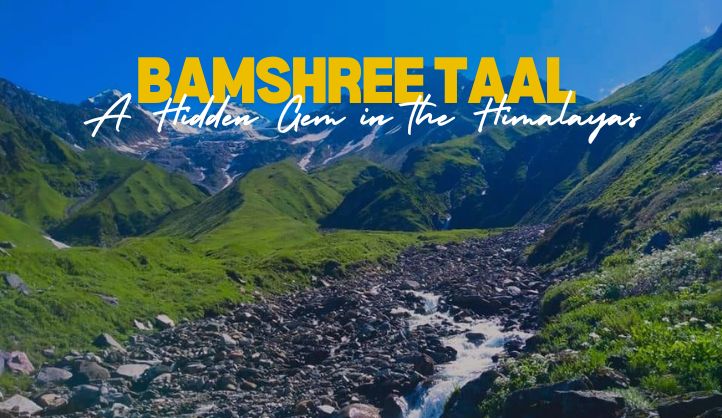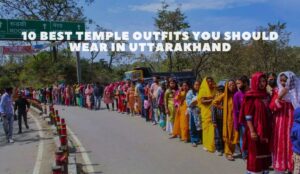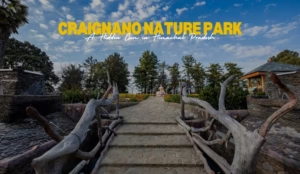The Indian Himalayas are home to countless hidden gems, and Bamshree Taal (also known as Bamshree Lake) is one such treasure nestled in the state of Uttarakhand. This pristine and relatively unexplored lake offers adventure seekers, nature lovers, and trekkers an unforgettable experience. The Bamshree Taal Trek, with its stunning landscapes, lush forests, and tranquil waters, is a peaceful escape from the chaos of city life.
Bamshree Taal is a serene high-altitude lake located in the Kumaon region of Uttarakhand. Surrounded by dense forests, rugged mountains, and meadows, this hidden lake offers a peaceful retreat for adventurers and nature lovers. The lake remains relatively less frequented by tourists, making it an ideal destination for those seeking solitude in the lap of nature. The tranquility of Bamshree Taal is enhanced by the crisp mountain air, clear skies, and the reflections of the surrounding trees on the still waters of the lake.
Geographical and Cultural Significance
Uttarakhand, often referred to as “Dev Bhoomi” or the “Land of the Gods,” is dotted with sacred lakes and mountain ranges. Bamshree Taal lies within this sacred landscape and holds cultural significance for the local communities, who have lived in harmony with nature for centuries. The lake is situated at an elevation of approximately 2,500 meters (8,200 feet) above sea level, offering breathtaking panoramic views of the surrounding peaks and valleys.
The cultural richness of the Kumaon region adds a layer of mystique to the trek. Local legends and folklore are deeply tied to the natural elements of the area. Villagers in the region often recount stories of divine spirits that guard the lake and its surroundings, making it a place of reverence.
Bamshree Taal Trek Overview
The Bamshree Taal Trek is categorized as a moderate trek, making it suitable for both beginner and experienced trekkers. The trail offers a variety of terrains, from dense oak and pine forests to open meadows and rocky paths. The total trekking distance is around 25 kilometers, spread over two days, with the altitude gain being gradual yet noticeable as trekkers ascend to the lake.
The trek begins in a small village (the base camp) located near the town of Almora, which is accessible by road. The path takes you through enchanting forests, over streams, and across ridges before finally revealing the sparkling Bamshree Taal in a secluded alpine setting.
Trek Itinerary
Day 1: Arrival and Acclimatization
- Destination: Base camp near Almora
- Altitude: 1,500 meters (4,920 feet)
- Activities: Explore the village, meet the locals, and acclimatize to the altitude.
The trek begins with an arrival at the base camp, a picturesque village near Almora. Upon arrival, trekkers have the opportunity to explore the surroundings, interact with the local community, and enjoy the traditional Kumaoni hospitality. This day is crucial for acclimatization, allowing trekkers to adjust to the altitude before beginning the trek.
Day 2: Trek to Bamshree Taal
- Distance: 10-12 kilometers
- Altitude: 2,500 meters (8,200 feet)
- Trekking Time: 6-8 hours
The trek to Bamshree Taal starts early in the morning. The trail gradually ascends through lush forests of oak, deodar, and rhododendron, with the sound of chirping birds and rustling leaves accompanying the journey. Trekkers will encounter small waterfalls and streams along the way, providing refreshing breaks.
As you continue ascending, the forest opens up to offer stunning views of distant peaks. The air becomes cooler, and the vegetation changes as you gain altitude. After several hours of trekking, the trail reveals the pristine Bamshree Taal, nestled in a peaceful valley surrounded by towering trees and rocky cliffs. Upon reaching the lake, trekkers can set up camp by its shores and enjoy the serene ambiance.
Day 3: Explore Bamshree Taal and Surroundings
Explore the lake, short hikes to nearby viewpoints, and photography.
Day three is dedicated to exploring the lake and its surroundings. The still waters of Bamshree Taal reflect the surrounding landscape, creating a picture-perfect scene. Trekkers can take a stroll around the lake, enjoy the tranquility, and capture stunning photographs. For those seeking more adventure, there are short hikes to nearby ridges and viewpoints, offering panoramic views of the Himalayan ranges.
Local guides may also share stories and folklore associated with the lake, adding a cultural dimension to the experience. The day ends with a bonfire by the lake, where trekkers can relax and share stories under the starry sky.
Day 4: Return to Base
- Distance: 10-12 kilometers
- Trekking Time: 5-6 hours
On the final day, trekkers retrace their steps back to the base camp. The descent is relatively easier, allowing trekkers to enjoy the scenery without the effort of climbing. The return journey provides a chance to reflect on the beauty of the trek and the peaceful moments spent by Bamshree Taal. Upon reaching the base camp, trekkers can rest and celebrate the successful completion of the trek.
Flora and Fauna
The Bamshree Taal region is rich in biodiversity, making it a paradise for nature lovers. The dense forests that surround the lake are home to a wide variety of flora and fauna. Trekkers may encounter oak, pine, deodar, and rhododendron trees along the trail. During spring, the rhododendrons bloom in vibrant red and pink, adding color to the landscape.
Wildlife enthusiasts can spot several bird species, including Himalayan monal, woodpeckers, and eagles. The forests are also home to animals like Himalayan black bears, leopards, barking deer, and langurs. While sightings of larger mammals are rare, the presence of diverse wildlife adds to the charm of the trek.
Best Time to Visit
The best time to undertake the Bamshree Taal Trek is during the spring (April to June) and autumn (September to November) seasons. During these months, the weather is pleasant, with clear skies and moderate temperatures. The spring season offers blooming flowers and lush greenery, while autumn provides crisp air and vibrant foliage.
Monsoon months (July to August) should be avoided due to heavy rainfall, which can make the trail slippery and dangerous. Winter (December to February) brings snowfall, which makes the trek more challenging but offers a different kind of beauty for experienced trekkers.
Cultural Insights
The region surrounding Bamshree Taal is steeped in cultural heritage. The local villages have preserved their traditional way of life, and trekkers can witness the simplicity and warmth of the Kumaoni people. The locals are deeply connected to the land, and their customs and festivals are often centered around nature and spirituality.
Many villages in the Kumaon region follow eco-friendly practices, and visitors are encouraged to respect the environment during their stay. Interaction with the villagers offers a glimpse into their daily lives, traditional farming methods, and the cultural significance of the lake.
Packing Tips and Essentials
Packing for the Bamshree Taal Trek requires careful consideration, as the terrain and weather can vary. Here are some essentials to bring:
- Clothing: Layered clothing to adapt to temperature changes, including thermal wear, trekking pants, and waterproof jackets.
- Footwear: sturdy trekking shoes with good grip for uneven terrain.
- Backpack: A comfortable backpack with a rain cover.
- Camping Gear: tent, sleeping bag, and sleeping mat (if not provided by tour operators).
- First-Aid Kit: Basic medical supplies, including bandages, antiseptics, and any personal medication.
- Trekking Poles: helpful for maintaining balance on rocky or uneven sections.
- Water Bottle: Stay hydrated during the trek.
- Snacks: energy bars, nuts, and dried fruits for quick energy boosts.
Nearby Attractions
While Bamshree Taal is a destination in itself, there are several nearby attractions and trekking opportunities that can be explored to extend your adventure in the region. Some of these include:
1. Binsar Wildlife Sanctuary
Located near Almora, Binsar Wildlife Sanctuary is a paradise for wildlife enthusiasts and nature lovers. The sanctuary is home to diverse flora and fauna, including leopards, barking deer, and numerous bird species. It also offers panoramic views of Himalayan peaks such as Nanda Devi, Trishul, and Panchachuli.
2. Jageshwar Temples
For those interested in history and spirituality, the Jageshwar Temples, located around 35 kilometers from Almora, are a must-visit. This ancient complex of over 100 stone temples dates back to the 9th century and is dedicated to Lord Shiva. The tranquil surroundings and the spiritual energy of the site make it an ideal stop for cultural exploration.
3. Kasar Devi
Kasar Devi, a small village near Almora, is known for its spiritual significance and stunning views. The village is famous for the Kasar Devi Temple, which has attracted spiritual seekers and artists from around the world. The area offers peaceful surroundings for meditation and relaxation, as well as short hikes to nearby viewpoints.
4. Zero Point
For breathtaking panoramic views of the snow-clad Himalayan range, a visit to Zero Point within the Binsar Wildlife Sanctuary is highly recommended. The short trek to this viewpoint takes you through dense forests and offers a sweeping vista of the majestic peaks.
5. Almora Town
Almora is the cultural heart of Kumaon, offering visitors a glimpse into the region’s history and traditions. With its bustling bazaars, old temples, and colonial-era architecture, Almora is a fascinating blend of the past and present. Visitors can explore local crafts, purchase handmade woolen products, and sample traditional Kumaoni cuisine.
Conclusion
The Bamshree Taal Trek offers a perfect blend of adventure, serenity, and natural beauty. It’s a journey that takes you through some of the most pristine landscapes in the Indian Himalayas, from dense forests to tranquil alpine meadows, culminating in the peaceful embrace of Bamshree Taal. This relatively undiscovered gem allows trekkers to escape the crowds and reconnect with nature in its purest form.
FAQs on Bamshree Taal Trek
1. What is the best time to trek to Bamshree Taal?
The best time to trek to Bamshree Taal is from April to June and September to November. During these months, the weather is pleasant, with clear skies and mild temperatures, making it ideal for trekking. The post-monsoon period offers lush greenery and blooming wildflowers, while the pre-winter months bring crisp air and scenic views of the snow-clad peaks.
2. How difficult is the Bamshree Taal Trek?
The Bamshree Taal Trek is considered a moderate trek. While it doesn’t involve technical climbing, trekkers should be prepared for uphill climbs, rocky terrain, and some physically demanding sections. A reasonable level of fitness and prior trekking experience is recommended, especially since the trek involves long hours of walking through varied landscapes.
3. How do I reach the starting point of the Bamshree Taal Trek?
The Bamshree Taal Trek generally starts from Almora, a town in Uttarakhand. Almora is well-connected by road and can be reached via bus or taxi from major cities like Delhi and Dehradun. The nearest railway station is Kathgodam, around 90 km from Almora. From Kathgodam, one can hire a taxi or take a bus to Almora, where the trek begins.
4. Are guides necessary for the Bamshree Taal Trek?
While it is possible to trek independently if you are an experienced trekker familiar with the region, it is highly recommended to hire a local guide. A guide can help with navigation, ensure your safety, and provide insights into the local culture, flora, and fauna. Additionally, a guide can assist in arranging homestays or campsites and managing logistics in remote areas.
5. What are the accommodation options during the Bamshree Taal Trek?
Accommodation during the Bamshree Taal Trek typically includes camping and homestays in nearby villages. Trekkers can carry their own camping gear or opt for guided treks that provide tents and sleeping bags. In some sections of the trek, local villagers offer simple, rustic homestays that allow trekkers to experience Kumaoni hospitality and culture.





